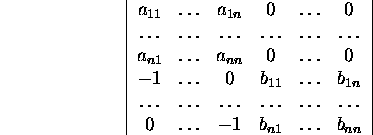Let us consider an ![]() matrix,
the so-called matrix of order n
matrix,
the so-called matrix of order n

Definition 2.3.1. Arbitrary
ordering ![]() of indeces
of indeces ![]() is called a permutation.
is called a permutation.
Definition 2.3.2.
The ordering of two indeces in the permutation ![]() is called natural if the smaller index stands before the greatest
one; in the opposite case, the greater index standing before the smaller
one, it is said that the two indeces form an inversion.
is called natural if the smaller index stands before the greatest
one; in the opposite case, the greater index standing before the smaller
one, it is said that the two indeces form an inversion.
Definition 2.3.3. A determinant
is a law (mapping, function) that associates with each square matrix A
a number, so-called determinant of the matrix

where the summation goes over all the permutations
![]() of indeces
of indeces ![]() and
and ![]() is the number of inversions in the permutation
is the number of inversions in the permutation
![]() of the row indeces. We will use expressions: determinant of order n
and its rows and cocumns.
of the row indeces. We will use expressions: determinant of order n
and its rows and cocumns.
Example 2.3.1. Let us consider the third order
determinant

![]()
![]()
Let us examine the last summand (-1)3a13a22a31.
In the permutation 3 2 1 of the column indeces
the index 3 forms with the index 2 and the index 1 an inversion.
The index 2 does the same with the index 1. So the number of inversions
![]() in the permutation of the column indices is equal to 3.
in the permutation of the column indices is equal to 3.
Problem 2.3.1.* Which sign has the product
![]()
of elements of determinant expression.
Properties of determinant

Example 2.3.2. Let us evaluate the determinant
of order n, using the expansion by cofactors by the first column
and then by the first row.


![]()
or
![]()
Equation (1) is a linear
homogeneous difference equation with constant coefficients which has the
solution of type ![]() Let us try to find them:
Let us try to find them:
![]()
We are interested in non-trivial solution. So we have get a quadratic equation
![]()
to find the solution of the difference equation (1). It
has the solutions ![]() ,
and so one of the solutions of equation (1) is Dn=(-1)n.
As the number -1 is a double solution of the quadratic equation, Dn=(-1)nn
will be a solution of the equation (1), too. Thus, we
have got two linearly independent particular solutions of the linear
homogeneous difference equation with constant coefficients. The general
solution of the equation can be expressed in form
,
and so one of the solutions of equation (1) is Dn=(-1)n.
As the number -1 is a double solution of the quadratic equation, Dn=(-1)nn
will be a solution of the equation (1), too. Thus, we
have got two linearly independent particular solutions of the linear
homogeneous difference equation with constant coefficients. The general
solution of the equation can be expressed in form
![]()
From the conditions D1=-2 and D2=3
we can find the coefficients C1 and C2:
![]()
So the given problem has the solution
![]()
Problem 2.3.2.* Compute the determinant
of order n

Example 2.3.3. Evaluate the Vandermonde
determinant

We substract x1 times the penultimate row from the last
row, then x1 times the (n-2)-th row from the penultimate
row, then x1 times (n-3)-th row from the (n-2)-th
row etc., in the end x1 times the second row from the
first one. As a result, we get

Using the expression by the first column and factoring out the common factors
in the elements, we get

Factoring out from the first columns the common factor x2-x1,
from the second column ![]()
![]() , from the (n-1)-th column xn-x1,
we get
, from the (n-1)-th column xn-x1,
we get

Using the same operations cycles, we shall result in
![]()
Proposition
2.3.1 (The Laplace expansion theorem). It holds the so-called
Laplace formula
![]()
where the summation on the right goes over all determinants
(minors) Mk of order k that
can be formed of rows i1, i2, ![]() , ik and columns j1, j2,
, ik and columns j1, j2,
![]() , jk, and An-k is
the product of the number
, jk, and An-k is
the product of the number ![]() and the determinant of the matrix remaining from the matrix A by
deleting the rows i1, i2,
and the determinant of the matrix remaining from the matrix A by
deleting the rows i1, i2, ![]() , ik and the columns j1, j2,
, ik and the columns j1, j2,
![]() , jk used ny forming the minor Mk.
, jk used ny forming the minor Mk.
Proof. See Kangro
(1962, pp. 37-39). ![]()
Example 2.3.4. Using the Laplace
expansion by two first rows, transform the determinant

As only three minors not equal to zero can be formed
the two first rows, we get the expansion

![]()
Problem 2.3.3.* Compute by the use of
the Laplace formula the determinant

By the Laplace expansion
theorem, it holds for each matrix  the equality
the equality

Choosing  we transform the determinant
we transform the determinant

so that all the elements bij become zeros. To make ![]() into zeros we have to add to the (n+1)-th column b11
times the elements of the first column, b21 times the
elements of the second column etc, and, in the end, bn1
times the elements of the n-th column. Next we make into zeros the
elements
into zeros we have to add to the (n+1)-th column b11
times the elements of the first column, b21 times the
elements of the second column etc, and, in the end, bn1
times the elements of the n-th column. Next we make into zeros the
elements ![]() For this we add to the (n+2)-th column b12 times
the first column, b22 times the second column etc, and,
in the end, bn2 times the n-th column
etc. The last step will nullity the elements
For this we add to the (n+2)-th column b12 times
the first column, b22 times the second column etc, and,
in the end, bn2 times the n-th column
etc. The last step will nullity the elements ![]() For this we add to the 2n-th column b1n
times the first column, b2n times the second column
etc, and, in the end, bnn times the n-th column.
The result will be
For this we add to the 2n-th column b1n
times the first column, b2n times the second column
etc, and, in the end, bnn times the n-th column.
The result will be



where
![]()
Taking into account (2) and the fact that, by (3),
![]() ,
we reach the assertion.
,
we reach the assertion.
Proposition 2.3.1 (the
theorem about the determinant of the product of matrices). For arbitrary
matrices A and B of order n it holds
![]()
![]()
![]()
![]()